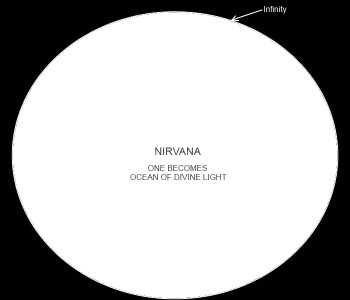Buddhism FAQ0 >> 2.What is Enlightenment
Buddhism FAQ
(Frequently Asked Questions About Buddhism)
2. What is Enlightenment? What are the Trance States?
Note1:All Trance states(jhana/dhyan/zen) come under the superset called Samadhi as described by Lord Buddha in the Eightfold path and knowledge gained from observing the Trance States is called Panna.
Note2: This page tries to explain the highest meditative states to be achievable in Buddhism. The knowledge is mentioned in only few places in Buddha's teachings. This is not explained to lay persons & even not to novice monks. But here it is. Please do not change.
Ans : Achievement of Enlightenment means achieving Trance States (also called samadhi). Buddha has described 9 Trance states (sometimes also divided in 4 jhanas[zen] ) which are achieved through 1.intense meditation & 2.following celibacy(Brahmacariya) & other moral principles(non-violence,non-stealing, no-lies, non-intoxication etc.)
see : SN_36.19_Pancakanga_Sutta, Vibhanga-Scanned-Chap.12, Vibhanga-Scanned-Chap.10 etc.
see : What is Buddhism & What is Buddhist Awakening
Meditation or Sati
Watching all organs & trying to awaken these using meditation(sati).
Note: All Jhana/Samadhi states are blissful, the difference is in attitude.
1. Bliss of First Trance(Jhana/Dhyan/Zen/Samadhi)-First Awakening Within Self- Thoughts With Discernment(Viveka Samadhi)
A monk quite withdrawn from sensual pleasures, withdrawn from harmful(akushala) qualities(anger, hatred,sexual passion, greed & worldly desires) — enters & remains in the first jhana(trance): with bliss(pitisukham) born from withdrawal, but remaining with directed thoughts & (savittakam savicharam) & discernment (vivekajam).
(Note : With practice of meditation focusing on body & mind with equanimity, rapture occurs, awareness is withdrawn from senses & from body , withdrawn within spine & brain where a great light is perceived along with great bliss. Here mind is with thoughts. Buddha, as Prince Siddharth, was already born with this state from childhood , being an advanced being who had been meditating in past lives.)
2. Bliss of Second Trance(Jhana/Dhyan/Zen/Samadhi)- Thoughtlessness(Avitark-Samadhi)
A monk, with the (tranquility) stilling of all (types of) thoughts (avittakam avicharam) , enters & remains in the second jhana (trance) of meditation (samadhi), with bliss(pitisukham) born of meditation, unification(singularity, Ekodibhavam) of awareness(chetaso) free from all (types of) thoughts & with internal assurance.
(Note : With state similar to earlier, tranquility of mind is also achieved along with greater bliss. Here mind is without thoughts)
3. Bliss of Third Trance(Jhana/Dhyan/Zen/Samadhi)-Blissful (Piti-sans.Preeti/Sukhvihari-Samadhi)
A monk, being equanimous(Upekkho) to bliss(Piti), he remains knowing-wholly(sampajano) about sensations(patisamvedeti) of the body(Kaayein) in meditation(Sato). He enters & remains in the third jhana (trance), of which the Noble-Ones (Ariya) declare, 'Equanimous & detached(Upekkho) & mindful/meditating(Satima), he has a blissful abiding(Sukhvihari).
(Note : With state similar to earlier, equanimity of mind & body with great bliss , the bliss being enjoyed.)
4. Bliss of Fourth Trance(Jhana/Dhyan/Zen/Samadhi)-Equanimous & Detached i.e. Beyond Likes & Dislikes (Upekkha-Samadhi-Sans.-Upeksha-Samadhi)
A monk, with the abandoning of pleasure & stress/suffering — as with the earlier disappearance of elation & distress — enters & remains in the fourth jhana(trance): purity of equanimity & mindfulness, neither-enjoying-pleasure-nor-pain(detachment). (from this state onwards the meditator experiences the body becoming totally still as if into benign paralysis but awakened within).
5. Bliss of Fifth Trance (Jhana/Dhyan/Zen/Samadhi)-Perception of Infinite Space (Ananto-Akaso-Sans.-Anant-Akash-or-Akasanacayatanam-Samadhi)
A monk, with the complete transcending(samatikamma) of (worldly) form-perceptions(Rupa-sannanam, sanskrit:sangyanam), with the disappearance of perceptions of resistance(patigha-sannanam), and not heeding perceptions of diversity(nanatta-sannanam) (within self), (now perceiving) 'Infinite space is this(ananto akasoti),' enters & remains in the dimension of the infinitude of space (akasa-ananch-ayatanam; sanskrit : anant akash ayatanam) (fifth trance state).
(Note : Can perceive into infinite space. I see all. Here the ability to perceive with divine eye extends upto infinity. Can see any world, planet, stars etc visible as well as invisible. The magical abilities start from here but limited to knowing only. However if a person remains busy in knowing various worlds, it impedes progress so one is required to move ahead & meditate further.)
Stages 5 & 6 of awakening/ trance/ enlightenment
6. Bliss of Sixth Trance (Jhana/Dhyan/Zen/Samadhi)-Experience of Omnipresence/Infinite Consciousness(Anantam-Vinnana-Sans.-Anant-Vigyan-or-Vinnananacayatanam-Samadhi)
A monk, with the complete transcending (samatikammam) of the dimension of the infinitude of space (akasa-ananch-ayatanam), (now perceiving) 'Infinite consciousness(anantam vinnananti) ,' enters & remains in the dimension of the infinitude of consciousness(vinnan-ananch-ayatanam; sanskrit: anant vigyan ayatanam) (sixth trance state).
(Note : Awareness expands out of body in all directions upto infinity, silently, being able to exist anywhere/everywhere & perceiving all, omnipresence. I am everywhere. Magical abilities are gained from here to see as well as to manipulate. However if a person remains busy in seeing & manipulating , one's progress may be hindered. Besides if one makes wrong move against Dharma then one may get into state of punishment by natural justice. Wisdom is to remain in the path to meditate more & progress further)
Stages 5 & 6 of awakening/ trance/ enlightenment
7. Bliss of Seventh Trance (Jhana/Dhyan/Zen/Samadhi)-Nothingness/Emptiness(Akincannayatanam-Samadhi-Sans.-Akincan-Ayatan-Samadhi)
A monk, with the complete transcending(samatikammam) of the dimension of the infinitude of consciousness (vinnan-ananch-ayatanam), (now perceiving,) 'There is nothing(natthi kinchiti),' enters & remains in the dimension of nothingness(akinchan-ayatanam) (seventh trance).
(Note : Realizing Nothingness/Emptiness of Worldly Dimension. This like a paper on which picture of universe is on one side and on when turned 90 degrees one sees only the edge i.e. the picture disappears from view. Transcendence starts from here.)
8. Bliss of Eigth Trance (Jhana/Dhyan/Zen/Samadhi)-Transcendence(Nev-Sanna-Na-Asanna-Ayatanam-Samadhi-Sans.-Nev-Sangya-Na-Asangya-Samadhi)
A monk, with the complete transcending (samatikammam) of the dimension of nothingness (akinchan-ayatanam), enters & remains in the dimension of neither perception nor non-perception (nev-sanna-na-asannayatanam; sanskrit : nev-sangya-na-asangya-ayatanam) (eigth trance).
(Note : All worlds fade away & worldly consciousness also fades away)
9. Bliss of Ninth Trance (Jhana/Dhyan/Zen/Samadhi)-Final Enlightenment-Nibbana/Nirvana (Nirodha-Samadhi)

Nirvana : Final stage 9 of awakening / trance / enlightenment.
A monk, with the complete transcending(samatikammam) of the dimension of neither perception nor non-perception (nev-sanna-na-asanna-ayatanam), enters & remains in the cessation of perception & feeling (sanna-vedayit-nirodham; Sanskrit : sangya vedana nirodham) (ninth final trance - state of nibbana).
The main difference between this & other states is that in this fully realized state the person loses one's sense of self(I).
(Note : Realizing Final , transcendental, non-worldly state of timelessness,super-consciousness, omnipresence, eternal life & eternal Bliss- The Nibbana State- after realizing which , there will be no rebirth therefore, hence no suffering ever i.e. supreme bliss for eternity.)
Another way of depicting Nibbana in relation to other creatures.
Also see : Buddhism FAQZZ Meaning of Life
see : SN_36.19_Pancakanga_Sutta
Original Words of Buddha , Pali Version(English)
Original Words of Buddha , Pali Version(Devnagari)









